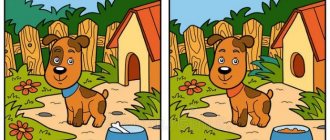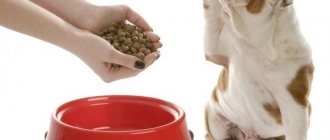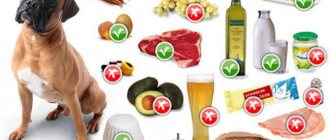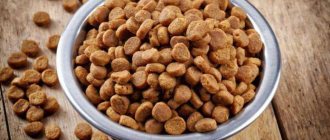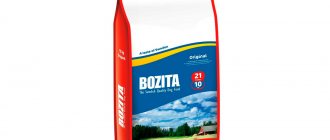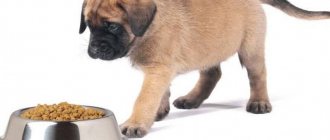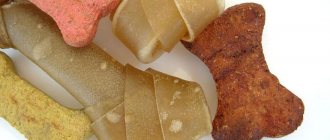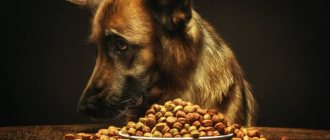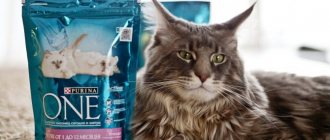Features of feeding a Maltese dog
So, the agony of choosing a dog is over and you have purchased a representative of the Maltese or Maltese mini breed, which is a fairly similar breed.
The very first thing you will face is the question of what to feed your Maltese. To help you figure it out, I am publishing this article with photos. The health and activity of an animal largely depend on how balanced its diet is and whether it contains all the microelements and vitamins necessary for the animal. The wrong diet can cause your dog's coat to become dull and brittle or cause digestive problems.
What to choose as food for a Maltese dog? Ready-made dry food or a diet consisting of natural products? This choice depends not only on the owner, but also on the preferences of the dog itself.
Judging by the reviews of our readers, miniature, snow-white creatures are sometimes quite picky in terms of feeding and the owner will have to try to ensure that the chosen standard of food not only meets all the requirements, but also pleases the dog himself.
Unlike the Bichon Frize, for some Maltese, dry food is a real treat, while others may completely refuse crunchy kibble, as they prefer boiled meat and vegetables. Therefore, in order to satisfy the taste preferences of his pet, the owner must try to offer the dog exactly the food that he likes most.
In no case should you overfeed a Maltese dog, as representatives of this breed are prone to obesity, which not only significantly spoils the dog’s appearance, but can also cause the development of various chronic diseases.
If your miniature dog has digestive problems due to food
A common reason for visiting a veterinarian is gastrointestinal problems. Not a single animal is safe from them.
The reasons for their appearance are usually quite similar: either a specific brand of ready-made dry or wet food is not suitable for the animal, or the owner decides to save money and buys cheap brands of food that have an unbalanced and sometimes even harmful composition.
The most common digestive disorders are:
- Diarrhea, constipation
- Allergies that cause a skin reaction
- Intolerance to components included in the finished feed
- Uncontrollable vomiting
- Poisoning
For each of these symptoms, the dog should be shown to a veterinarian to establish an accurate diagnosis and prescribe treatment. Self-medication or self-diagnosis is fraught with the emergence of new diseases. If you do not review your dog’s diet, then over time, minor problems with the gastrointestinal tract will lead to the development of chronic diseases of the internal organs.
Damage will mainly be caused to the stomach and liver, as well as to various parts of the intestines.
To solve the problem, it is enough to change the brand of food, choosing a diet without harmful and poorly digestible components. A competent veterinarian can advise which food is best to introduce, based on the health of a particular dog. Change the food gradually; too sudden a change will cause severe digestive upset. The replacement should be made within a week, mixing the new type of food with the old one.
Dry food
Some owners are confident that the Maltese should be fed exclusively natural food, since dry granules are harmful to the dog’s health. According to other owners of miniature pets, ready-made dry food contains all the necessary additives and elements, so it is excellent for feeding a Maltese dog. What is the right approach?
Theoretically, by giving preference to natural food, the owner can always be confident in the quality and freshness of the products. However, this is a misconception. None of the world's dry food manufacturers would risk introducing ingredients that are dangerous for dogs into production. At the same time, not everyone has the time and opportunity to prepare food for their pet every day, and in this case, dry food will be an excellent alternative to natural food.
Of course, food that is too cheap can harm the health of your snow-white pet, since unscrupulous manufacturers add cheap flavors and preservatives instead of useful substances, but these are few. But well-known, well-known manufacturers do not allow this to happen, and you can safely switch your dog to their dry food. Especially if you can afford premium and holistic food, made from high-quality meat ingredients and additionally enriched with all the necessary minerals and vitamins.
In addition, there are special types of feed. They are made taking into account the current state of the body and health indicators. An example would be foods intended for dogs that have been sterilized or are allergic to certain foods. Very interesting for Maltese dogs are special foods for dogs with white hair.
It is also important that in ready-made food there is a balanced ratio of proteins, carbohydrates and fats, while when feeding natural food, the owner has to independently calculate the balance of all these parameters. It is not recommended to combine dry and natural food, as this can cause problems with the animal’s digestive system.
If your pet is okay with dry food and eats it with pleasure, then it would be better to stick with dry food. This is the right choice.
Modern manufacturers have achieved perfection and currently their products meet all the norms and standards of proper feeding.
Go! Natural Holistic (holistic menu) Go & NOW Natural (690 g)
Suitable for all dog breeds, especially miniature ones. It contains only natural ingredients, such as calf meat, turkey, lamb, duck, fruits, berries, and vegetables.
The product is perfectly balanced, the necessary animal proteins, carbohydrates, fiber, microelements, acids are present, while at the same time there are no harmful soybeans, preservatives, odor and taste enhancers, or low-quality by-products. All components retain their beneficial properties thanks to gentle processing.
pros
- convenient sealed packaging with a zipper: the food does not expire and does not lose its beneficial properties;
- the amount of excrement is significantly reduced, and its smell becomes much less pronounced;
- high calorie content, the dog remains full for a long time;
- the coat becomes more shiny and smooth in appearance with prolonged constant feeding;
- does not cause allergies or dental problems;
- the condition of the skin and eyes improves noticeably over time;
- can be found in almost every pet store;
- does not have a pronounced odor.
Minuses
- large granules that are difficult to digest if the dog does not chew them;
- possible smell from the animal’s mouth;
- Occasionally, problems with the gastrointestinal tract occur.
Grocery list
- Porridge made from rice, buckwheat, oatmeal, pearl barley, and rolled oats flakes;
- Fresh herbs - parsley, dill, cilantro;
- Fermented milk products (kefir, cottage cheese, natural yogurt);
- Meat products (lean pork, beef, chicken or turkey);
- Beef or pork by-products;
- Cartilaginous components of the joints and throat;
- Vegetables (carrots, tomatoes, cucumbers, zucchini, pumpkin);
- Boiled chicken egg whites. Yolks are sometimes possible and only after one and a half years of age;
- Sea fish, as there are too many bones in the river fish.
For breakfast, the dog is cooked porridge, mixing it with pieces of boiled meat and vegetables. Add chopped greens and a few drops of vegetable oil to the food. In addition, it is recommended to add a few drops of a mixture of fat-soluble vitamins - trivit or tetravit.
For dinner, you can offer your pet low-fat cottage cheese, boiled egg white or boiled sea fish.
A couple of times a week, you can pamper your snow-white friend with a vitamin salad made from nuts, honey and finely chopped dried apricots or prunes.
When feeding your pet natural food, vitamins should be given with food. Water-soluble ones are given directly, like candy, and fat-soluble ones are added to food.
In older dogs, the need for plant fiber increases, so more vegetables and dairy products are introduced into their menu, and cereals and meat are given in limited quantities.
The French and British developed a special diet for the snow-white creatures. The staples of the English diet are goat's milk, porridge and scrambled eggs. French Maltese fans suggest feeding their miniature pets chicken or beef, cottage cheese and fresh fruits and vegetables.
If the owner decides to choose a French or English diet as food, then he should remember that the puppy must be accustomed to such feeding from a young age so that the dog gets used to such a diet normally.
style=»text-align: justify;»>Interesting photos
List of prohibited products
A dog will never refuse to try food from the owner’s plate, and many owners allow their charming pet such a whim, without even suspecting that this can cause irreparable harm to its health.
What foods are contraindicated for lap dogs:
- Smoked meat;
- Sausage;
- Potato;
- Canned fish and meat for people;
- Flour and confectionery products;
- Chocolate;
- Hard varieties of cheese;
- White cabbage, cauliflower, potatoes;
- Legumes (peas, soybeans, beans);
- Animal or bird bones.
If your dog loves sweets, you can treat him with a piece of oatmeal cookies or special sweet biscuits intended for decorative breeds of dogs. You can easily buy them at a specialized pet food store.
If your eyes are running
Perhaps it makes sense to say a few words about the most common problem of this breed. I am often asked what to feed Maltese to prevent his eyes from running? I have to disappoint fans of natural feeding. My advice is to switch to premium dry food.
You are unlikely to be able to accurately determine which specific natural product is an allergen for your pet. For some it's chicken, for others it's beef liver. You will spend a long time going through the options and it’s not a fact that you will be able to get to the bottom of the truth. It is best to simply switch to super premium dry food and thus definitely eliminate all allergic reactions. I would recommend Choice Hypoallergenic ALL BREEDS or Grandorf Holistics. These feeds give very good results.
Choosing food for small breed dogs
Small breed dogs are characterized by high nervous excitability, a predisposition to the formation of tartar, necrosis of the femoral head, and dislocation of the patella. Small dogs often suffer traumatic brain injuries and limb injuries. Neutered small breed dogs are prone to obesity.
In order to avoid these problems, it is necessary to choose food taking into account the weight, age and breed of the dog. Most manufacturers produce separate lines specifically for small breed dogs. These foods have a high percentage of linoleic acid and B vitamins; these elements support high energy levels in small dogs. The beneficial substances in such foods are aimed at preventing excess weight gain, dental problems, and the development of allergies.
The rating of dry food for small breed dogs includes the following foods:
- Acana small (holistic class)
- Wellness Simple (holistic class)
- 1st Choice Adult Dog TOY BREEDS – Healthy Skin & Coat (super premium)
- Almo Nature Holistic Adult Dog Small – Chicken&Rice (super premium class)
- Eukanuba Breed Specific Yorkshire Terrier (premium class with increased quality indicators, suitable for Yorkshire Terriers, Cavalier King Charles Spaniels, Shih Tzus, Miniature Poodles and Toy Poodles)
- Hill's Ideal Balance Canine Adult Small Breed (premium class with increased quality indicators).
To summarize, it should be noted that for the health and well-being of the dog, of course, it is recommended to choose super-premium and holistic food. Economical dry food will help save money, but will have a detrimental effect on the health and life of the pet.
Fans of miniature dogs with luxurious snow-white fur were the ancient Greek philosopher Aristotle and the French queen Marie Antoinette. Maltese dogs are still very popular among dog lovers, who value them not only for their attractive appearance, but also for their friendly, easy-going character.
To keep your pet healthy and always look well-groomed, you need to pay attention not only to caring for its long, white fur, but also to choose the right feeding strategy for your pet.
Feeding the puppy
In puppies under six months of age, the digestive system is not yet fully formed, so the owner should pay special attention to feeding the young, growing body.
When purchasing a puppy from a nursery or from a private breeder, despite the price of the puppy, the owner needs to ask how and what he was fed during the first weeks. This is necessary in order to adhere to the same diet. New products should be introduced into the animal’s menu gradually, since a sudden change in diet can cause constipation, diarrhea or dyspeptic disorders.
Initially, small puppies up to two months old are fed frequently, up to six times a day. Then, every two months, this amount is reduced by removing one feeding. Thus, when the puppy is six months old, you need to feed it four times a day, then you should transfer the puppy to three feedings a day.
Calculate the amount of food per meal yourself based on the puppy’s needs. Starting with one tablespoon, you will gradually work up to the volume of a small bowl. The main rule is that the puppy must eat everything at once! If there is anything left in the bowl, you are overfeeding!
Features of feeding Maltese puppies
Puppies do not require a varied diet. But it is imperative to understand how to feed a Maltese puppy correctly. Every day you need to give your dogs porridge made from buckwheat or rice, adding beef, turkey or rabbit meat. In addition, you need a small spoon of vegetable oil and one vitamin. Sometimes you can give sea fish. The main thing is that there are no bones.
Food should be varied every day with fermented milk products and fresh cottage cheese. You can also use cottage cheese intended for baby food. Chopped greens, fruits, vegetables (can be boiled or given raw) should be included in the diet. You can flavor the porridge with any vegetable oil.
What about natural food?
The question of what to feed a 1-month-old Maltese puppy should not pose any difficulties if you use ready-made food that is balanced in the content of nutrients. But if you choose natural food as food, then it should be enriched:
- Proteins.
- Fats.
- Fast doubling carbohydrates.
- A large group of minerals.
- Vitamins.
These components must be introduced as additives. Let us immediately clarify that natural food in some situations, for example, while traveling, is not always convenient to prepare. In addition, there is a risk that some products may provoke an allergic reaction. All this needs to be taken into account.
Features of feeding adult Maltese
If you have a Maltese dog, the amount of food from 6 months onwards will be slightly different. With a weight of 2.5 to 3 kilograms, at least 150 grams of feed will be required daily for feeding.
What should a Maltese eat?
No matter how old your Maltese dog is, there are some foods that should never be included in their diet. This:
- Sweets, smoked foods, pickles, hot and spicy foods.
- Meat with bones.
- Pickled vegetables, sausages.
- Chocolate and chocolate candies.
- Spicy cheeses, cakes and pastries are contraindicated.
Potatoes, any varieties of cabbage, green peas are undesirable. It's better not to risk your pet's health. If the dog has just been running or playing, it should not be fed immediately, as this may result in vomiting.
Maltese breeders recommend
People who breed dogs, including Maltese dogs, most often use ready-made food for feeding in their factories. After all, they are balanced in components and do not contain products that can provoke an allergic reaction. Moreover, with professional food, the time associated with satiation of pets is reduced.
Animals eat such food with pleasure. Among the prepared foods there are also special dog treats, which include cookies. It can be given after the main meal. These treats should not contain manganese.
The amount of food needed per feeding is indicated on the package. When accustoming to a new coma begins, it is added in minimal doses. It is imperative to monitor the dog's condition. If red spots appear under the eyes, you should stop introducing this food.
Choose the right diet, your pets will delight you with their healthy appearance, snow-white silky fur and activity.
1st Choice Breeders for miniature breeds with chicken (20kg)
The best option among super-premium feeds.
It consists of high-quality meat, vegetables, and does not contain unnecessary third-rate components and by-products. The composition also does not contain taste or smell enhancers or other artificial additives. The price per kilogram (366 rubles/kg) is quite affordable for a product of this quality. In addition to this product, there is a wide range of small breed foods in other flavors, including hypoallergenic varieties that are suitable for animals prone to allergies.
pros
- there is no unpleasant odor, the animal’s mouth does not smell after eating;
- the condition of the coat improves;
- does not cause digestive upset, suitable for animals with a weak gastrointestinal tract;
- Each product in the line is balanced according to the age of the animal for which it is intended (this product for adult miniature dogs contains the required 22% protein);
- does not cause allergies;
- Convenient packaging with a clasp, the product does not run out.
Minuses
- has the form of granules, which are much more difficult to digest when not chewed;
- difficult to find in pet stores.
Maltese food. Maltese feeding
Every owner of a pet such as a Maltese dog knows very well that in order for his puppy to grow up healthy, beautiful and cheerful, he must take care of proper and balanced nutrition. First, you need to find out from the breeder how and what the dog was fed. Since, usually, breeders feed exclusively with professional balanced ready-made food, which is most suitable for this breed of dog.
Do not forget that the breed is snow-white. Therefore, if you choose the wrong food, you may see a not very positive result, which will manifest itself in the appearance of smudges under the eyes of the animal. When choosing food, it is imperative to study the composition. It should be noted that food that contains rice and lamb or turkey is excellent for Maltese. You need to be careful with ingredients such as chicken, as this product causes allergies in some dogs. There are cases that red smudges may appear under the eyes.
When the Maltese dog's diet includes ready-made food, the need for mineral and vitamin supplements is reduced to a minimum. This is due to the fact that in the finished food the ratio of all the ingredients the dog needs is already correctly balanced in advance, and does not require additional additives.
If you decide to feed your pet natural food, then when forming a diet, you need to pay attention to the fact that the proteins, fats and carbohydrates contained in the food must be easily digestible, and the vitamins and minerals must be present in the required proportions. Excess protein due to metabolism is modified into fat deposits, such excess can lead to kidney disease. For particularly sensitive animals, fat deposits initiate food allergies.
Mainly the following balance of food ingredients in the diet of an adult dog: 50 percent proteins, 25 percent vegetables, fruits, 25 percent cereals. The main criterion is that all food must be freshly prepared. When consuming natural feed, you need to add appropriate mineral and vitamin supplements. When introducing a new product, you should monitor the dog and if red streaks appear from the eyes that stain the fur, then this product needs to be replaced with another more suitable one.
- Until 6 months of age, feed puppies about four times a day.
- After 6 months - no more than 3 times.
- Adult Maltese dogs usually eat 2 times a day.
The most suitable diet for a small Maltese consists of small amounts of high-calorie food: raw or boiled meat (for example, beef), boiled chicken, rabbit, fish and turkey. Your pet's daily diet should also include fermented milk products. For example, yogurt, fermented baked milk or kefir. Low-fat cottage cheese is best made from kefir. The list of foods consumed includes rice and buckwheat porridge, greens, salad, and fruits. As for vegetables, these are cucumbers and red bell peppers. Finely chop fruits and vegetables and season with drops of vegetable oil.
It is very useful to add finely chopped walnuts with the addition of a small amount of honey (half a coffee spoon) to the dog’s main diet, approximately three times a week. Once every seven days, it is better to mix the yolk with cottage cheese and add one teaspoon of olive oil.
Making a daily menu from the above products is not difficult. But it is worth considering that Maltese are conservative eaters. And remember that properly selected food is not only the key to your pet’s health, but also a beautiful, flowing, silky coat.
You need to drink and eat enough so that your strength is restored and not suppressed.
The debate over what to feed dogs has divided dog breeders into two camps. Some people welcome dry food, while others prefer to prepare food for their pets themselves from regular food products.
Modern premium food for small dogs, produced by well-known global companies, is a complete source of nutrients. They have a balanced composition of proteins, fats and carbohydrates. They are specially enriched with minerals, vitamins and antioxidants. The basis of such feed is high-quality meat and fish. This food is very convenient to use for feeding Maltese dogs. It has a number of advantages:
- Simply pour the required amount of food into a clean bowl.
- The food does not spoil even in extreme heat.
- The dog can eat food when it has an appetite.
- Dry food does not stain the luxurious fur on the face and neck.
- It is convenient to determine the amount of feed, since it is indicated on the packaging.
The main condition for using dry food is the constant availability of a bowl of clean drinking water.
Natural food
Natural food has its advantages:
- fresh foods rich in beneficial nutrients are used;
- fresh vegetables and fruits contain the maximum amount of essential minerals and vitamins.
the owner knows what is included in the pet’s diet;
Along with the advantages of natural food, it also has disadvantages:
- Liquid food contaminates the wool and deteriorates its quality. When feeding this way, it is necessary to wipe or wash the fur on the animal’s face and neck after eating. The remains of such food give a yellowish color and an unpleasant odor to the Maltese's face.
- When preparing natural food, it is necessary to strictly adhere to the requirements for the content of nutrients in the diet, since the health of the animal depends on its nutritional value and usefulness.
- In the warm season, leftover food left uneaten by a dog quickly deteriorates, which forces the owner to “force” the animal to immediately eat the entire portion or put it in the refrigerator (if the dog does not want to eat the food right away).
The Maltese is not a dog that will be content with leftover food from the master's table, since improper feeding will lead to deficiencies in the dog's development, deterioration in its health and unsightly appearance. You cannot feed animals with various sweets intended for humans. They can harm your Maltese's health and cause food allergies. Maltese dogs are fed only those treats that are intended for such dogs.
Acceptable natural products used as treats:
- Low-fat hard cheese.
- Chicken and beef pieces (no fat).
You should not feed your Maltese pickled foods, smoked foods, or fatty foods. You should not overfeed the animal, as this quickly leads to obesity. Natural feeding will require mineral and vitamin supplementation. Natural fats, proteins and carbohydrates should be easily digestible, since excess protein is transformed into fatty deposits and leads to kidney disease or food allergies.
The most balanced ratio of foods for the diet of an adult dog:
- protein foods (boiled or raw beef; boiled chicken, turkey, rabbit, sea fish; fermented baked milk, yogurt, low-fat cottage cheese, kefir) – 50%;
- vegetables, fruits, herbs (apples, red peppers, cucumbers, dill, parsley) – 25%;
- cereals (rice, buckwheat) – 25%.
Natural food should only be freshly prepared. To correctly calculate such a diet, it is best to contact Maltese breeders or an experienced veterinarian.
Feeding adult dogs is different from feeding puppies. Up to 6 months, puppies are fed 4-5 rubles. per day, and after 6 months - 2-3 rubles. Adult Maltese dogs are fed no more than 2 times a day.
Experts do not recommend feeding dogs such as the Maltese with economy-class food, since it does not contain all the nutrients they need and often leads to yellowing of the fur on the face. The daily feed consumption is relatively small, so the cost of high-quality dry food will not be significant. When feeding ready-made food, you must adhere to the norm recommended on the packaging. The amount of food depends on the age, weight and physical condition of the dog.
To create ideal conditions for feeding, use a special stand for a bowl of food and water at a suitable height (the dog should be free to consume food while standing, without bending its legs and neck). In this way, the show dog's stance will be developed correctly every day.
The best food for Maltese is one specifically designed for this breed or Yorkshire Terrier, which is made from lamb and turkey. When feeding high-quality dry food, no vitamin-mineral supplements or other additives are required. If you decide to get yourself a Maltese, use the best ready-made food that will make your life easier and keep your pet healthy for many years.
The diet for a Maltese dog should be selected very carefully. You especially need to pay attention to the calorie content of the food, the presence of vitamins and microelements in it, and compliance with the feeding regimen.
Most representatives of the breed, even in puppyhood, give preference to one food or another and remain faithful to their choice throughout their lives. You shouldn't force feed your dog food he doesn't like. If she refuses dry food, you need to try to diversify her diet with natural food.
Any food should be high in calories, but under no circumstances should you offer it to your lapdog in large portions. The volume of one feeding should be no more than 2 tbsp. for every kilogram of animal weight. An adult Maltese dog should be fed 2-3 times a day.
The best food for a Maltese dog is natural. At the same time, the following products must be present in the dog’s diet:
- veal or beef;
- chicken;
- chicken eggs;
- buckwheat porridge, rice;
- vegetables, fruits, herbs;
- fish;
- dairy products;
- walnuts.
Meat, fish, vegetables and eggs should be boiled and thoroughly chopped. Under no circumstances should Maltese dogs be offered smoked meats, sweets, cakes or baked goods. You can choose adapted food for nutrition, however, feeding with natural products is preferable.
An indicator that the Maltese diet is chosen correctly is the appearance of the dog’s coat. If it shines, shimmers in the sun and does not split and is of sufficient length, then the owner has nothing to worry about. However, if the dog’s coat has an unsightly dull appearance, falls out and is split, this indicates that there are serious shortcomings in the Maltese’s nutrition.
Health
In general, the health of Maltese dogs does not cause any concern - these animals are not prone to frequent manifestations of any diseases. Only occasionally do some representatives of the breed develop diseases, the most common of which are:
- luxating patellas, which are common in most toy dogs;
- heart disease;
- hydrocephalus;
- glaucoma, retinal atrophy and blocked tear ducts;
- dermatitis;
- otitis media and deafness.
These diseases are congenital or inherited; all of them are easily diagnosed in puppyhood, and some can be successfully treated.
In the first year of life, diseases such as viral hepatitis and distemper are dangerous for the Maltese dog. To protect it from these diseases, it is necessary to receive special preventive vaccinations in the first months of the dog’s life.
Due to the fact that small dogs have very poor thermoregulation, any overheating or hypothermia is very dangerous for all of them. To avoid colds, it is better to refrain from walking your Maltese in damp, cold weather.
If the owner of a Maltese dog pays close attention to the state of its health, he will be able to notice in time and prevent the development of any disease in his pet.
A snow-white Maltese puppy will certainly become everyone's favorite. But family members are faced with the question of how to properly feed a Maltese puppy.
You need to resolve the issue of feeding when purchasing a dog by asking the breeder. Most often, balanced foods are used to feed babies, which contain all the necessary elements. Remember that improper feeding can cause smudges under the eyes.
Meat and cereal products must be included in the diet. If you use ready-made food, it contains all the vitamins and minerals. If you are feeding natural products, you will have to think about nutritional balance. Try not to feed your lapdogs chicken, as this product can cause allergies.
Diet for a pregnant miniature dog
Pregnancy of a pet is an important moment; it is necessary to organize the correct diet for the animal. It is advisable to avoid sudden changes in diet; pregnancy is stressful for the pet and changing the diet can aggravate the pet’s condition. The main part of the menu should be animal proteins. An overweight towards fast carbohydrates and fats can only provoke the appearance of excess weight.
It is better to choose premium dog food intended for pregnant females; as a rule, they have a good composition and contain a balanced set of vitamins and minerals necessary for a pregnant animal. It is important to monitor the portions you consume. Excessive feeding can lead to excess weight gain; there is no need to feed your pet for two or three. Additional weight can weaken the dog’s labor and also add increased stress to the internal organs.
In the first half of pregnancy, the animal is usually fed according to the usual schedule, maintaining the portion size that was before pregnancy. To avoid weight gain, small pets need to remain active, but it is important to remember that you should not overwork the animal during pregnancy. If it was decided to switch the animal to another food, then the best time for this is the first half of pregnancy. The transition is carried out smoothly, on average about 8-10 days. If the new food is not suitable for a particular pet, the return to the previous one should also be gradual.
In the second half of pregnancy, active growth of puppies in the womb begins; if before this excess nutrition was spent on the pet’s excess weight, now all the excess will go to feed the fetuses. The animal’s body gives almost all of its resources to its offspring. It is important to gradually increase the pet's diet; by the end of pregnancy, the bitch should receive about 30% more food than usual.
There are periods when the female’s appetite decreases or even disappears. There is no need to force feed; when the dog feels better, it will begin to eat properly again. During this period, it is best to offer food frequently and in small portions. During pregnancy, the uterus puts a lot of pressure on the internal organs, and large portions of food will worsen the condition, and a lack of food will provoke the birth of weakened offspring.
Features of feeding Maltese dogs
Maltese belong to the category of dogs that you have to tinker with, but that’s why they are decorative. If you feed your lapdog the wrong thing, its coat will deteriorate, digestive upset will begin, and excessive tearfulness will develop. To avoid these problems, the owner must:
- Monitor your pet's weight. Obesity is a common problem for Maltese dogs, which is quite difficult to get rid of.
- Maintain proper regularity. For puppies, 5-6 feedings per day are enough to avoid feeling hungry. The older the dogs, the less often they are fed. For Maltese who are already one year old, 2 feedings per day are enough.
- Stick to the routine. It is recommended to bring your lapdog near the bowl at the same time every day. If the dog leaves uneaten food in the bowl, the leftovers should be thrown away without leaving them for later.
- Monitor the amount of protein your dog consumes. If a Maltese gets too much protein from food, it can cause digestive upset and/or allergies.
Important! You should not force your pet to eat food that it does not like, even if the food is high-quality and expensive; the same goes for natural food. To avoid problems with eating behavior, it is best to feed the Maltese with what the breeder fed it in the nursery. You need to transition your puppy to a different type of food gradually and carefully.
Feeding with natural food
The main advantages of “natural food” include the fact that the owner has complete control over the quality and freshness of the products. It is also worth noting that feeding food made from natural products is much cheaper than factory-made feed.
The list of approved and recommended products for Maltese dogs includes:
- Lean meats. The snow-white dog will like turkey, veal and rabbit meat. Boiled meat is given every day. By-products are allowed, but not too often.
- Omega-3 rich marine fish. Steamed fillet can be offered to your pet several times a week.
- Vegetables containing fiber and vitamins. Maltese's favorite foods are zucchini, tomatoes, pumpkin, cucumbers, beets and carrots. Vegetables must be heat treated and cut into small pieces.
- Fresh herbs, which can be either fresh or lightly cooked.
- Dairy and dairy-free porridges, which are cooked from rice, buckwheat, pearl barley or oatmeal.
- Chicken egg white. The white is offered to the lapdogs boiled; it is better not to give the yolks at all.
- Fruits that can act as a delicacy and be used as a separate dish. Maltese can be served with pears, apples, and melons. Citrus fruits are also allowed if the lapdog likes them.
- Milk, which is necessary for the development and strengthening of bones, improves metabolism. Bolonki can eat kefir, sour cream and cheese, low-fat cottage cheese.
Important! These products can be used to make soup or aromatic porridge for the snow-white lap dog.
Products that are prohibited
Even though a lapdog can easily be called an omnivore, there must still be restrictions in its diet. You can't feed your dog:
- confectionery products;
- fatty meat and bones;
- semi-finished meat products and sausage;
- baking;
- food prepared using seasonings and spices;
- potatoes;
- legumes
Important! Products and food from the human table are strictly prohibited.
Dry and wet food
Most breeders and owners prefer dry food. They choose “drying” because a high-quality product includes all the vitamins and minerals necessary for a dog, is balanced and easy to use. A veterinarian can advise which food to choose.
Purchased food is divided into several classes:
- Economy Products from this category are absolutely not suitable for the sensitive digestion of the Maltese.
- Premium Lapses like this kind of food because of its rich smell, but you shouldn’t expect any benefit from it.
- Super premium. You can already pay attention to such foods, since they contain meat and cereals.
- Holistic. The best and highest quality food that will fully satisfy the needs of lap dogs.
Important! In addition to granulated food, Maltese can be treated to canned food and bone-cookies.
Feeding tips for miniature dogs
To maintain the health of a small dog, it is important to consider recommendations and advice on feeding and managing the animal’s diet:
- It is advisable for miniature breeds to eat dry food daily. This is due to the fact that they often experience oral diseases: inflammation of the gums, unpleasant odor from the mouth, loose teeth, and excessive deposits of tartar. Diseases develop faster than in large individuals. Preference is given to holistic feeds; they do not contain dyes, preservatives, or by-products. Dry food reduces the risk of these diseases, but is not a panacea.
- The diet should include wet food. Miniature dogs are prone to diseases of the urinary system; due to their size, the kidneys produce a relatively small amount of urine, which contains a concentration of harmful inorganic substances. Wet food helps saturate the body with additional fluid and prevents the appearance of formations in the urinary system. It is not advisable to mix dry and wet food; it is better to offer them to the animal at different times.
- Do not choose your own nutritional supplements for the animal and do not give food from your table. The advantage of ready-made dry food is its balance. The substances your dog needs are available in the right quantities. Homemade table food contains a lot of salt, fat, spices, and other substances harmful to the animal. A dog whose diet is based on dry food does not need additional biological additives. An excess of vitamins is more harmful than their deficiency.
- Do not overfeed. Small individuals have a tendency to become obese. If you do not control the number of servings in the bowl, then over time the animal may become overweight. Packages of ready-made dry food usually have a table on portion sizes and feeding frequency. Compliance with these standards will protect your dog from weight problems.
How to feed puppies
It is necessary to pay a lot of attention to the nutrition of puppies, because the development and health of the dog as a whole depends on its quality. Those who have become the owner of a fluffy snow-white lapdog puppy for the first time will come in handy with the following advice from veterinarians:
- You can switch your puppy to food after he is 2 months old.
- During the period from 2 to 4 months, the puppy is fed frequently; the food should be nutritious and rich in vitamins.
- During the period of teeth change, which occurs at 5-6 months of age, you need to add cottage cheese, fish and sour milk to your daily diet.
- Boiled vegetables and meat are served to children cut into small pieces.
- To calculate the serving volume, you need to know the exact weight of the dog. To feed a 2 kg puppy, 4 tablespoons of food will be enough.
- Water should be near food. Puppies need to be given well-purified and boiled water.
Each owner chooses exactly how to feed the lapdog. If you have the time and desire to stand at the stove and cook for your dog separately, feel free to choose “in the morning.” If, on the contrary, you don’t want to spend an extra few hours a week fussing around in the kitchen, choose dry food. The main thing is that in both the first and second options the products are of high quality and fresh.
Useful materials:
- Maltese Maltese photo CharacterWanting to purchase a lapdog, future owners want to know about the advantages and disadvantages of the breed, but it is impossible...
- How to feed dogs? Types of dog food All food varies by type and class. The class of food refers to its...
- How to feed food Is it possible to feed a dog dry and natural food at the same time? The question is whether to give a dog at the same time...
- Dog food meal reviews Food review The dog owner no longer needs to prepare a special diet for his animal, since…
